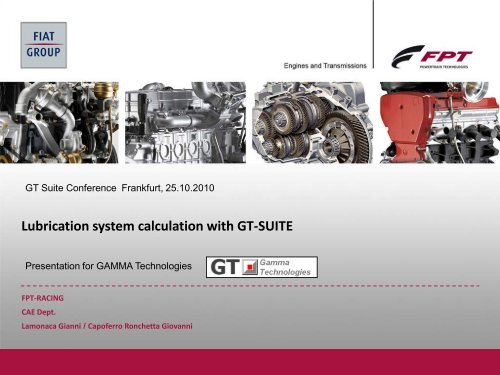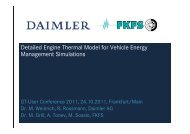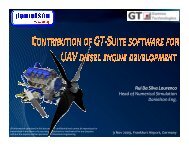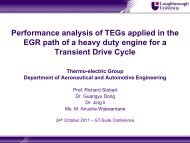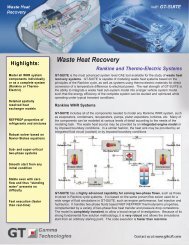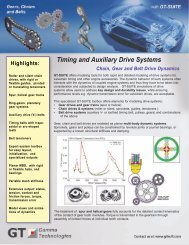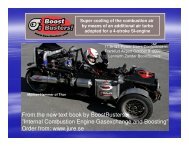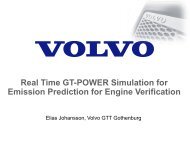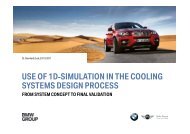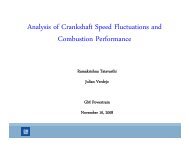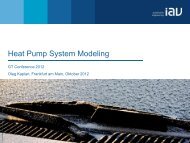Lubrication system calculation with GT-SUITE - Gamma Technologies
Lubrication system calculation with GT-SUITE - Gamma Technologies
Lubrication system calculation with GT-SUITE - Gamma Technologies
Create successful ePaper yourself
Turn your PDF publications into a flip-book with our unique Google optimized e-Paper software.
<strong>GT</strong> Suite Conference Frankfurt, 25.10.2010<strong>Lubrication</strong> <strong>system</strong> <strong>calculation</strong> <strong>with</strong> <strong>GT</strong>-<strong>SUITE</strong>Presentation for GAMMA <strong>Technologies</strong>FPT-RACINGCAE Dept.Lamonaca Gianni / Capoferro Ronchetta Giovanni
ContentsContentsPROJECT:<strong>Lubrication</strong> SystemCalculationGeometry of<strong>system</strong>Overview :Simulation modelMain features ofthe integratedmodelPROJECT: <strong>Lubrication</strong> System CalculationGeometry of <strong>system</strong>Simulation modelMain features of the Integrated ModelInput DataInput DataOperatingConditionsResultsOperating ConditionsResultsConclusions andfuture workConclusions and future workFrankfurt - October 2010, 25th 2
PROJECT: <strong>Lubrication</strong> System CalculationContentsPROJECT:<strong>Lubrication</strong> SystemCalculationGeometry of<strong>system</strong>Overview :Simulation modelMain features ofthe integratedmodelAIM OF ANALYSIS: 1D CFD for assessment of lubrication <strong>system</strong>‣Calculate oil flow rates and oil pressure levels for each oil consumer underdifferent engine conditions‣Determination of the required oil pump flow rate and pressure‣Optimization of the lubrication <strong>system</strong> geometry‣Evaluate effect of cam phaser leakage on oil flow rates and pressure levels‣Examine the operational safety for all engine operation conditions‣<strong>Lubrication</strong> analysis on bearingsSOFTWARE (version): <strong>GT</strong>-Suite (v6.2), build 10Input DataOperatingConditionsResultsINPUT<strong>GT</strong>-<strong>SUITE</strong>modelOUTPUTConclusions andfuture workFrankfurt - October 2010, 25th 3
Input data – Geometry of <strong>system</strong>ContentsPROJECT:<strong>Lubrication</strong> SystemCalculationGeometry of<strong>system</strong>Overview :Simulation modelMain features ofthe integratedmodelInput DataOperatingConditionsResultsConclusions andfuture workEngine geometry section<strong>Lubrication</strong> <strong>system</strong>Frankfurt - October 2010, 25th 4
Overview – Simulation modelContentsPROJECT:<strong>Lubrication</strong> SystemCalculationEntire modelAnti-drain valveGeometry of<strong>system</strong>Overview :Simulation modelMain features ofthe integratedmodelCylinder Head and cam phasersInput DataOperatingConditionsResultsConclusions andfuture workCrankcasePumpCranktrain andcounterbalanced shaftsFrankfurt - October 2010, 25th 5
Overview – Simulation base modelContentsPROJECT:<strong>Lubrication</strong> SystemCalculationGeometry of<strong>system</strong>CrankcaseMainbearingsPiston cooling jets(modeled <strong>with</strong> FlowMap)Overview :Simulation modelMain features ofthe integratedmodelOil filterHeatexchangerInput DataOperatingConditionsResultsConclusions andfuture workConrodbearingsOil pumpFrankfurt - October 2010, 25th 6
Overview – Simulation base modelContentsPROJECT:<strong>Lubrication</strong> SystemCalculationGeometry of<strong>system</strong>Overview :Simulation modelMain features ofthe integratedmodelInput DataOperatingConditionsResultsCylinder head - exhaust Cylinder head - IntakeTappetsCam PhasersFrom Main GalleryConclusions andfuture workTappets (modeled using an orifice connection element)Camshaft BearingsFrankfurt - October 2010, 25th 7
Overview – Simulation base modelContentsPROJECT:<strong>Lubrication</strong> SystemCalculationAnti-drain valve (situated between crankcaseand cylinder head)Geometry of<strong>system</strong>Overview :Simulation basemodelMain features ofthe integratedmodelInput DataModeled <strong>with</strong>BallPoppetSharpSeattemplateOperatingConditionsResultsConclusions andfuture workFrankfurt - October 2010, 25th 8
Overview – Simulation base modelContentsPROJECT:<strong>Lubrication</strong> SystemCalculationGeometry of<strong>system</strong>Quasi-dynamic model of cranktrain and counterbalanced shaftBearing andcounterbalanced shaftOverview :Simulation modelMain features ofthe integratedmodelInput DataOperatingConditionsResultsCrankshaftPistonsConrodsConclusions andfuture workFrankfurt - October 2010, 25th 9
Main features of the integrated modelContentsPROJECT:<strong>Lubrication</strong> SystemCalculationGeometry of<strong>system</strong>Overview :Simulation modelMain features ofthe integratedmodelInput DataMain bearings, con-rod bearings, and balance shaft bearings:speed and load calculated from mechanical model of thecranktrain, then imposed directly at bearings in the flowmodelcylinder pressure, piston and conrod mass and inertiaaccounted for in the forcesCamshaft bearing loads calculated using an EXTERNAL <strong>GT</strong>-<strong>SUITE</strong> dynamic model of intake and exhaust valvetrainsOperatingConditionsResultsConclusions andfuture workCRANKTRAIN MODEL(mechanical <strong>system</strong>)• Pump speed• Crankshaft loadsand speed• Counterbalanceshafts loads andspeedHYDRAULIC MODEL<strong>with</strong>oil pump and bearingsFrankfurt - October 2010, 25th 10
Input data – Consumers characteristics-01 (fluid-dynamic domain)ContentsPROJECT:<strong>Lubrication</strong> SystemCalculationGeometry of<strong>system</strong>Oil cooler characteristics:modeled <strong>with</strong> an OrificeConn <strong>with</strong> calibrated diameter and hole thickness toaccount for friction in the coolercalibrated orifice can be extrapolated to 140°C (not available in theexperiment)Overview :Simulation modelMain features ofthe integratedmodelInput DataOperatingConditionsResultsConclusions andfuture workFrankfurt - October 2010, 25th 11
Input data – Consumers characteristics-02 (fluid-dynamic domain)ContentsPROJECT:<strong>Lubrication</strong> SystemCalculationGeometry of<strong>system</strong>Oil filter characteristics:modeled <strong>with</strong> an OrificeConn <strong>with</strong> calibrated diameter and hole thickness toaccount for friction in the filtercalibrated orifice can be extrapolated to 120°C and 140°C (not available inexperiment)Overview :Simulation modelMain features ofthe integratedmodelInput DataOperatingConditionsResultsConclusions andfuture workFrankfurt - October 2010, 25th 12
Input data-Leakage through tappets (fluid-dynamic domain)ContentsPROJECT:<strong>Lubrication</strong> SystemCalculationGeometry of<strong>system</strong>Leakage through tappets (HLAs)Calculated using formula for leakage through a cylindrical guide <strong>with</strong>AnLeakConn <strong>with</strong> an external <strong>GT</strong>-<strong>SUITE</strong> valvetrain modeloil circuit model uses an OrificeConn <strong>with</strong> equivalent diameter in order toreduce simulation timeOverview :Simulation modelMain features ofthe integratedmodelFrom cylinder-headInput DataOperatingConditionsResultsConclusions andfuture workCylindricalgroove fortappet feedingFrankfurt - October 2010, 25th 13
Input data – Oil characteristicsContentsPROJECT:<strong>Lubrication</strong> SystemCalculationGeometry of<strong>system</strong>Overview :Simulation modelMain features ofthe integratedmodelInput Data10W-60 oil was used <strong>with</strong> the following characteristics:Characteristics 10W-60Density @ 15°C [kg/m 3 ] 850Density @100°C [kg/m 3 ] 790Kin viscosity @40°C [cSt=mm2/s] 151Kin viscosity @100°C [cSt=mm2/s] 22.8Viscosity vs temperature calculated <strong>with</strong> Walther equation basedon two kinematic viscosity data points.Density is assumed “quasi-linear” <strong>with</strong> temperature.OperatingConditions30°CResults50°CConclusions andfuture work140°CFrankfurt - October 2010, 25th 14
Input data – Oil pump mapping (fluid-dynamic domain)ContentsPROJECT:<strong>Lubrication</strong> SystemCalculationFPT - Gasoline Dept. provided the pump map for 90°C and 120°C90°C 120°CGeometry of<strong>system</strong>Overview :Simulation modelMain features ofthe integratedmodelInput DataOperatingConditionsResultsConclusions andfuture workThe pump map for 140°C oiltemperature is assumed using asemi-predictive model of thepump140°CFrankfurt - October 2010, 25th15
Input data-Semi-predictive model of oil-pumpContents1D modelization of semi-predictive oil pump and testing circuitPROJECT:<strong>Lubrication</strong> SystemCalculationGeometry of<strong>system</strong>Overview :Simulation modelOrifice to simulateimposed pressurelosses downstreamoil pumpOil pump <strong>with</strong> maps containinglinear characteristics of massflows versus pressure (red lines)Main features ofthe integratedmodelInput DataOperatingConditionsResultsOrifice to simulate relief valveSpring <strong>with</strong> 30N preloadConclusions andfuture workValve mass in contact <strong>with</strong>springs and pressure forcesacting on intake and exhasutside of oil pumpFrankfurt - October 2010, 25th 16
Input data – Anti drain valve (fluid-dynamic domain)ContentsPROJECT:<strong>Lubrication</strong> SystemCalculationAnti drain valve characteristics: the valve is modeled <strong>with</strong> asemi predictive modelGeometry of<strong>system</strong>Overview :Simulation modelMain features ofthe integratedmodelInput DataOperatingConditionsResultsConclusions andfuture workThe pre-compression force of ball valves is imposedequal to 0.21N and the stiffness equal to 0.04N/mmFrankfurt - October 2010, 25th 17
Operating conditionsContentsPROJECT:<strong>Lubrication</strong> SystemCalculationGeometry of<strong>system</strong>Overview :Simulation modelMain features ofthe integratedmodelInput DataOperatingConditionsResultsConclusions andfuture workThe <strong>calculation</strong>s have been conducted for the following operatingconditions:‣ “field condition”: oil temperature 90°C, nominal bearing clearances‣ “worst case” conditions 1: oil temperature 120° (pump map fromexperimental test), maximum bearing clearances‣ “worst case” conditions 2: maximum oil temperature 140°C (pump mapcalculated), maximum bearing clearancesBelow, the clearances used in the <strong>calculation</strong> for “field” and “worst” condition:Clearances Worst case Field conditionMain bearings [mm] 0.074 0.0525Con rod bearings [mm] 0.056 0.043Counterbalance shaft bearings [mm] 0.095 0.0775Tappets clearances [mm] 0.046+0.07*=0.116 0.03+0.07*=0.100Camshaft bearings (intake side) [mm] 0.06 0.045Camshaft bearing (exhaust side) [mm] 0.07 0.05*: increase due to cylinder-head temperature (assumed=100°C)Frankfurt - October 2010, 25th 18
Results: Base <strong>system</strong>ContentsGraphs below show pressure levels versus engine speedPROJECT:<strong>Lubrication</strong> SystemCalculationGeometry of<strong>system</strong>Overview :Simulation modelMain features ofthe integratedmodelPressure decreases due to lessresistance in the oil circuitInput DataOperatingConditionsResultsConclusions andfuture workFrankfurt - October 2010, 25th 19
Results: Modified <strong>system</strong>ContentsGraphs below show vol. flow rate vs. engine speed for each consumerPROJECT:<strong>Lubrication</strong> SystemCalculationGeometry of<strong>system</strong>Overview :Simulation modelMain features ofthe integratedmodelInput DataOperatingConditionsResultsConclusions andfuture workPiston cooling jet flow decreases inworst case condition due todecrement of oil pressure in themain galleryThe piston cooling jet characteristicsinfluence whole <strong>system</strong> pressureand flow rateMain bearing flow rate increases<strong>with</strong> temperatureFrankfurt - October 2010, 25th 20
Conrod bearings: minimum oil film thicknessContentsPROJECT:<strong>Lubrication</strong> SystemCalculationGeometry of<strong>system</strong>Overview :Simulation modelMinimum Film Thickness Study for worst possible conditionAssuming a worst case condition<strong>with</strong> maximum leakage through camphaser (~5L/min)Min. film thickness > 0.5µm for allcon rod bearingsMain features ofthe integratedmodelInput DataOperatingConditionsResultsConclusions andfuture workFrankfurt - October 2010, 25th 22
Cam Phasers Diameter variableContentsPROJECT:<strong>Lubrication</strong> SystemCalculationCam phaser leakage influence on rest of <strong>system</strong>even at worst (max) phaser leakage condition, there is adequate flow to mainbearings and piston cooling jetsGeometry of<strong>system</strong>Overview :Simulation modelMain features ofthe integratedmodelInput DataOperatingConditionsResultsConclusions andfuture workFrankfurt - October 2010, 25th 23
Computational timeContentsPROJECT:<strong>Lubrication</strong> SystemCalculationGeometry of<strong>system</strong>Overview :Simulation modelMain features ofthe integratedmodelIntegrated model is characterized by the following situationin terms of computational time using one workstationequipped <strong>with</strong> an Intel Xeon 3.33Ghz , 3 GB RAM:Simulation time is strongly affected by reaching convergenceon bearing flow and thermal balance!Mean value bearing model offers possibility to run muchfasterInput DataOperatingConditionsResultsConclusions andfuture workFrankfurt - October 2010, 25th 24
Mean Value Bearing ModelContentsPROJECT:<strong>Lubrication</strong> SystemCalculationGeometry of<strong>system</strong>Overview :Simulation modelMain features ofthe integratedmodelMean value bearing model replaces predictive bearings(JournalBearingFlow) <strong>with</strong> flow rate lookup tables (FlowMaps)DOE run on predictive bearing solution sweeping RPM, P, T,clearanceDOE results for flow and power loss placed into FlowMapResult: much faster running model <strong>with</strong> nearly identical resultsDetailed ModelMean Value ModelInput DataOperatingConditionsResultsConclusions andfuture workFrankfurt - October 2010, 25th 25
Conclusions and future worksContentsPROJECT:<strong>Lubrication</strong> SystemCalculationGeometry of<strong>system</strong>Overview :Simulation modelMain features ofthe integratedmodelInput DataOperatingConditionsResultsConclusions andfuture workConclusions‣ A detailed model of whole engine lubricating <strong>system</strong> has been developedin the <strong>GT</strong>-<strong>SUITE</strong> environment‣ <strong>Lubrication</strong> model (flow) integrated <strong>with</strong> detailed cranktrain model(mechanical) to account for proper bearing loads due to cylinder pressureand cranktrain/balance shaft mass/inertia‣ The developed model allows optimization of lubricating <strong>system</strong>characteristics and layout from early stage of engine designFuture developments‣ Further validation through experimental test‣ Reduce computational time via:‣ Distributed computing‣ Simulation of crankshaft using 3D-dynamic option <strong>with</strong> stiffness of eachcranktrain and <strong>system</strong> solved in a dynamic mannerFrankfurt - October 2010, 25th 26


